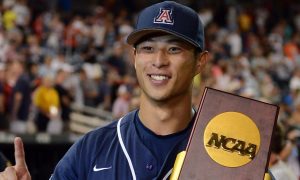[rps-paypal]
Memo to the NCAA: Rethink the composition of the NCAA baseball selection committee before you lose more followers of the sport.
I am all for the little guy against the big programs, but not to this degree. Having only four members from major-college institutions on the 10-person NCAA baseball selection committee is a farce.
And we wonder why college baseball — once a popular sport before the 1990s — continues to lose its luster.
Arizona baseball coach Andy Lopez, whose team won the College World Series last year as an at-large team from a major conference, went so far as to say he will not watch this season’s postseason.
“If I could leave the country for the next five weeks I would, because I don’t really pay attention to anything after this point because we didn’t get in,” Lopez was quoted as saying by Anthony Gimino of TucsonCitizen.com after the tournament field was announced Monday.
That’s not an elitist attitude. That is understandable frustration.
North Carolina athletic director Larry Gallo, Texas A&M athletic director Eric Hyman, Washington State senior athletic director Randy Buhr and Rice athletic director Richard Greenspan are the only members from major institutions on the selection committee.
The rest are from the Colonial Athletic Association, Binghamton, South Alabama, Central Michigan and Valparaiso. The chairman of the committee is Dennis Farrell of the Big West Conference.
NCAA BASEBALL TOURNAMENT BY CONFERENCE
By comparison, the NCAA men’s basketball tournament committee has only four members from smaller institutions: Big Sky and West Coast commissioners and the athletic directors at Northeastern and Utah State.
Of the 34 at-large teams selected for the NCAA baseball tournament last Monday, 11 are from schools who do not compete in major conferences. That number should be five or six.
The at-large teams from small conferences are Louisiana-Lafayette, South Alabama and Troy of the Sun Belt, Cal Poly and Cal-Santa Barbara of the Big West, North Carolina Wilmington and William & Mary of the Colonial Athletic Conference, Mercer of the Atlantic Sun, Coastal Carolina of the Big South, Sam Houston State of the Southland, and San Francisco from the West Coast.
Seven of these 11 teams have ties to three members of the selection committee: Farrell of the Big West, Colonial Athletic Conference senior associate commissioner Robert Goodman and South Alabama athletic director Joel Erdmann.
These 11 teams took the spots of bubble teams from major conferences, including Stanford and Arizona of the Pac-12, Ohio State of the Big Ten, Auburn of the SEC and Pitt and Seton Hall of the Big East.
The 11 teams are a combined 9-13 after the first two days of the tournament. None are 2-0. Mercer and Coastal Carolina were eliminated after losing their first two games.
Cal State Fullerton, of the Big West, is the only team not from a major conference that is 2-0. The Titans, however, are a No. 1 seed and they are playing at home. They are certainly a team from a smaller conference that belongs.
The counter argument to my point is that small-school Valparaiso eliminated Florida of the SEC and Ivy League champ Columbia eliminated New Mexico of the Mountain West.
My argument to that is Florida was a questionable addition to the tournament and the Lobos made the field as an at-large team. Florida is one of nine SEC teams that got into the field. The Gators finished their season 29-30 overall. They lost 11 of their last 15 games.
College baseball will continue to be back-page news nationally as long as 32 of the 64 teams in the field are from small conferences. That’s half of the field. That can not be a true representation of the talent across the nation. Otherwise, why is Fullerton the only one of these schools with a decent chance of advancing to the Super Regional round next week?
It is difficult to understand why larger conferences such as the SEC, ACC, Big 12, Pac-12, Big Ten, Big East, Mountain West, Atlantic 10 and Conference USA have the same amount of teams in the field as the Sun Belt, Big West, Colonial, Atlantic Sun, Big South, Southland, West Coast, America East, Horizon, Ivy, Metro Atlantic, Mid-American, Mid-Eastern, Missouri Valley, Northeast, Ohio Valley, Patriot, Southern, Southwestern, Summit and WAC.
Whew. A long list. Twenty-one smaller conferences.
How they got 32 teams in the field, instead of 26 or 27, should be front-page news for college baseball fans who still care.
WILDABOUTAZCATS.net publisher, writer and editor Javier Morales is a former Arizona Press Club award winner. He also writes blogs for Lindy’s College Sports, TucsonCitizen.com and Sports Illustrated-sponsored site ZonaZealots.com.
[rps-paypal]
|
|






























